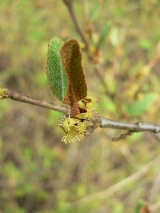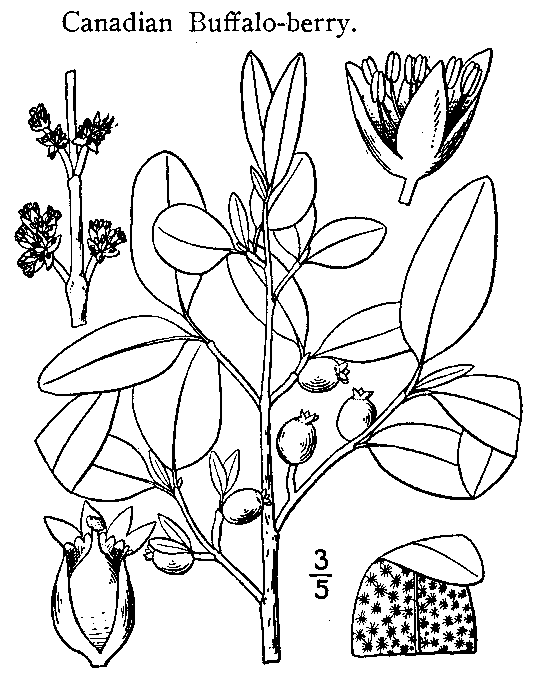
Canada Buffaloberry
Encyclopedia
The Canada Buffaloberry (Shepherdia canadensis), also known as Russet Buffaloberry, Soopolallie, Soapberry, or Foamberry, is one of a small number of shrubs of the genus Shepherdia bearing edible red berries
. One recognized form however bears yellow fruit
s. The berries have an extremely bitter taste.
The plant is a deciduous
shrub found in open forests and thickets all over North America
. Its northern limit is around the Arctic Circle
. The shrub reaches a height of 1–4 m (3–13 feet).
Fruits are extensively collected by some Canadian First Nations
peoples such as Nlaka'pamux
(Thompson), St'at'imc
(Lillooet) and Secwepemc
(Shuswap
) in the province of British Columbia
. The bitter berries are not eaten directly but rather processed as sxusem ("sxushem", also xoosum/"hooshum") or "Indian ice-cream
". Branches bearing fruit are hit with a stick and only the very ripe fruits that fall off are collected. A clean mat or tarpaulin is placed below the bush for collection. The berries are later placed into a great bowl that is absolutely free of oil or fat and are mixed with some sweet fruit such as raspberries. The mixture of berries is crushed and vigorously beaten in the manner of whipping cream in order to raise the typical foam of the confection. The berry has an agreeable blend of sweet and somewhat bitter tastes, possibly comparable to that encountered in sweetened coffee. The substance is believed by the First Nations peoples who prepare it to have many healthful properties, but the saponin
chemicals making up the foam may also cause gastrointestinal irritation if consumed greatly. Native theme restaurants in British Columbia have occasionally had sxusem on the menu in recent years.
 Persons reading about saponins should be forewarned that unrelated plants in the genus Sapindus
Persons reading about saponins should be forewarned that unrelated plants in the genus Sapindus
, which produce highly toxic saponins, share the common name soapberry with the edible Canada Buffaloberry. References to Sapindus "soapberry" toxins should not be misattributed to Canada Buffaloberry.
The common name of the plant in British Columbia is soopolallie, a word deriving from the historic Chinook Jargon
trading language used in the North American Pacific Northwest in the 19th and early 20th centuries. The name is a composite of the Chinook words for soap (soop) and berry (olallie).
Berry
The botanical definition of a berry is a fleshy fruit produced from a single ovary. Grapes are an example. The berry is the most common type of fleshy fruit in which the entire ovary wall ripens into an edible pericarp. They may have one or more carpels with a thin covering and fleshy interiors....
. One recognized form however bears yellow fruit
Fruit
In broad terms, a fruit is a structure of a plant that contains its seeds.The term has different meanings dependent on context. In non-technical usage, such as food preparation, fruit normally means the fleshy seed-associated structures of certain plants that are sweet and edible in the raw state,...
s. The berries have an extremely bitter taste.
The plant is a deciduous
Deciduous
Deciduous means "falling off at maturity" or "tending to fall off", and is typically used in reference to trees or shrubs that lose their leaves seasonally, and to the shedding of other plant structures such as petals after flowering or fruit when ripe...
shrub found in open forests and thickets all over North America
North America
North America is a continent wholly within the Northern Hemisphere and almost wholly within the Western Hemisphere. It is also considered a northern subcontinent of the Americas...
. Its northern limit is around the Arctic Circle
Arctic Circle
The Arctic Circle is one of the five major circles of latitude that mark maps of the Earth. For Epoch 2011, it is the parallel of latitude that runs north of the Equator....
. The shrub reaches a height of 1–4 m (3–13 feet).
Fruits are extensively collected by some Canadian First Nations
First Nations
First Nations is a term that collectively refers to various Aboriginal peoples in Canada who are neither Inuit nor Métis. There are currently over 630 recognised First Nations governments or bands spread across Canada, roughly half of which are in the provinces of Ontario and British Columbia. The...
peoples such as Nlaka'pamux
Nlaka'pamux
The Nlaka'pamux , commonly called "the Thompson", and also Thompson River Salish, Thompson Salish, Thompson River Indians or Thompson River people) are an indigenous First Nations/Native American people of the Interior Salish language group in southern British Columbia...
(Thompson), St'at'imc
St'at'imc
The St'át'imc are an Interior Salish people located in the southern Coast Mountains and Fraser Canyon region of the Interior of the Canadian province of British Columbia.St'át'imc culture displayed many features typical of Northwest Coast peoples: the...
(Lillooet) and Secwepemc
Secwepemc
The Secwepemc , known in English as the Shuswap people, are a First Nations people residing in the Canadian province of British Columbia. Their traditional territory ranges from the eastern Chilcotin Plateau and the Cariboo Plateau southeast through the Thompson Country to Kamloops and the Shuswap...
(Shuswap
Shuswap
Shuswap *Secwepemc - an indigenous people in British Columbia, Canada, also known in English as the Shuswap*Shuswap language - a language spoken by the Secwepemc...
) in the province of British Columbia
British Columbia
British Columbia is the westernmost of Canada's provinces and is known for its natural beauty, as reflected in its Latin motto, Splendor sine occasu . Its name was chosen by Queen Victoria in 1858...
. The bitter berries are not eaten directly but rather processed as sxusem ("sxushem", also xoosum/"hooshum") or "Indian ice-cream
Indian ice-cream
Sxusem or Indian ice-cream is a dessert made by native people throughout the Pacific Northwest region of North America. It is made by crushing the saponin-containing berries of the Canada Buffaloberry . The liquid produced is mixed with equal parts of water and whipped with a whisk. This produces a...
". Branches bearing fruit are hit with a stick and only the very ripe fruits that fall off are collected. A clean mat or tarpaulin is placed below the bush for collection. The berries are later placed into a great bowl that is absolutely free of oil or fat and are mixed with some sweet fruit such as raspberries. The mixture of berries is crushed and vigorously beaten in the manner of whipping cream in order to raise the typical foam of the confection. The berry has an agreeable blend of sweet and somewhat bitter tastes, possibly comparable to that encountered in sweetened coffee. The substance is believed by the First Nations peoples who prepare it to have many healthful properties, but the saponin
Saponin
Saponins are a class of chemical compounds, one of many secondary metabolites found in natural sources, with saponins found in particular abundance in various plant species...
chemicals making up the foam may also cause gastrointestinal irritation if consumed greatly. Native theme restaurants in British Columbia have occasionally had sxusem on the menu in recent years.

Sapindus
Sapindus is a genus of about five to twelve species of shrubs and small trees in the Lychee family, Sapindaceae, native to warm temperate to tropical regions in both the Old World and New World. The genus includes both deciduous and evergreen species. Members of the genus are commonly known as...
, which produce highly toxic saponins, share the common name soapberry with the edible Canada Buffaloberry. References to Sapindus "soapberry" toxins should not be misattributed to Canada Buffaloberry.
The common name of the plant in British Columbia is soopolallie, a word deriving from the historic Chinook Jargon
Chinook Jargon
Chinook Jargon originated as a pidgin trade language of the Pacific Northwest, and spread during the 19th century from the lower Columbia River, first to other areas in modern Oregon and Washington, then British Columbia and as far as Alaska, sometimes taking on characteristics of a creole language...
trading language used in the North American Pacific Northwest in the 19th and early 20th centuries. The name is a composite of the Chinook words for soap (soop) and berry (olallie).
External links
- Soopolallie (Shepherdia canadensis)
- Sxusem berry picking and related linguistics
- Turner, Nancy J, Laurence C. Thompson, M. Terry Thompson and Annie Z. York. 1990. Thompson Ethnobotany. Royal British Columbia Museum: Victoria. Pp. 209–211.

